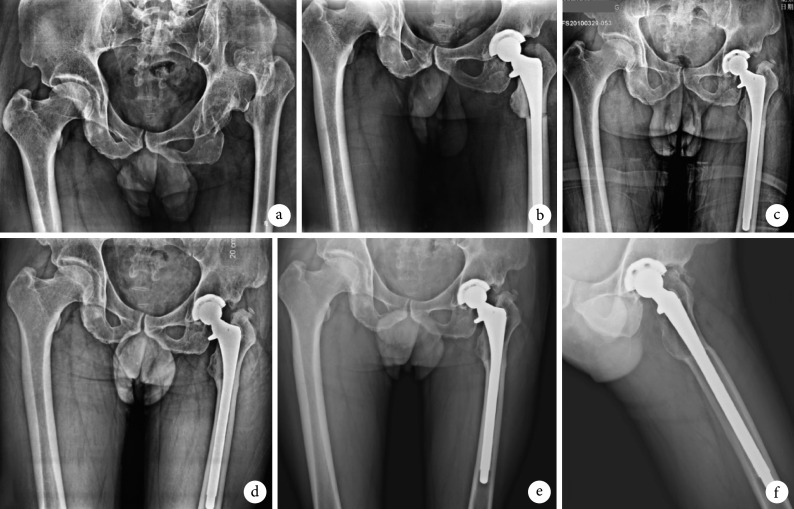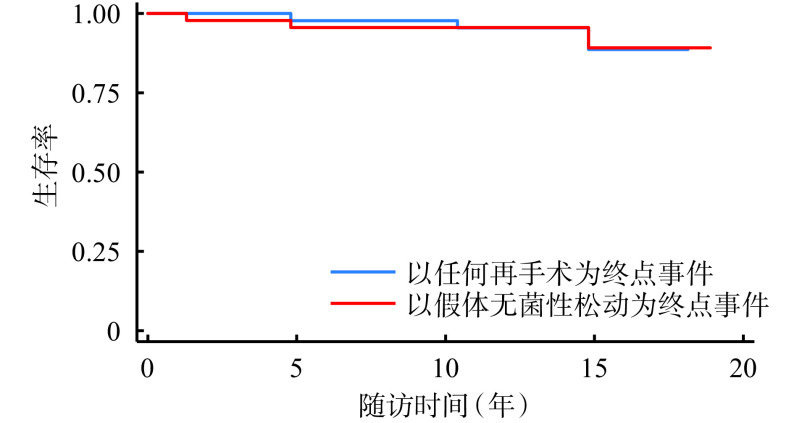Abstract
目的
探讨初次人工全髋关节置换术(total hip arthroplasty,THA)治疗 Crowe Ⅳ型发育性髋关节发育不良(development dysplasia of the hip,DDH)的远期疗效。
方法
回顾性分析 2002 年 1 月—2008 年 8 月因 Crown Ⅳ型 DDH 行初次 THA 且随访达 13 年的患者临床资料,共 42 例(45 髋)符合选择标准纳入研究。男 13 例,女 29 例;年龄 18~65 岁,平均 43.5 岁。单髋 39 例,双髋 3 例。术前髋关节 Harris 评分为(38.3±10.7)分。单侧置换患者双下肢长度差值为(50.52±24.51)mm。术中 19 髋联合股骨转子下短缩截骨术,截骨长度为 15~35 mm,平均 25 mm。记录患者髋关节 Harris 评分、主观满意度、假体生存率、并发症发生情况,以及相关影像学观测指标。
结果
患者均获随访,随访时间 13.0~19.6 年,平均 15.0 年。术后发生股神经损伤症状 1 髋、关节脱位 2 髋、假体周围骨折 1 髋、假体周围关节感染 1 髋;无其他并发症发生。末次随访时,髋关节 Harris 评分为(82.1±9.3)分,较术前改善(t=−21.885,P=0.000)。患者自评满意度:非常不满意 3 髋、较不满意 1 髋、一般 4 髋、较满意 17 髋、非常满意 20 髋。X 线片复查显示,术后即刻患侧大转子高度为 3.01~51.60 mm,平均 23.22 mm;大转子下移量为 3.95~98.06 mm,平均 48.20 mm;患侧肢体延长长度为 3.95~61.63 mm,平均 34.92 mm;单侧置换患者双下肢长度差值为(12.61±8.56)mm,较术前缩短(t=11.721,P=0.000);患侧臼杯旋转中心与泪滴连线垂直距离为(14.65±6.16)mm,与健侧(15.60±4.99)mm 比较,差异无统计学意义(t=−0.644,P=0.525);水平距离为(22.21±5.14)mm,与健侧(34.48±5.63)mm 比较,差异有统计学意义(t=−12.973,P=0.000)。除 1 髋截骨不愈合外,其他患者截骨均愈合良好。随访期间所有假体近端多孔涂层部分均获得了稳定骨长入,无连续放射性透亮线或者放射性硬化线。以任何再手术、假体无菌性松动为终点事件,假体生存率分别为 88.64% [95%CI(63.73%,96.82%)]、89.19% [95%CI(65.61%,96.94%)]。
结论
Crowe Ⅳ型 DDH 患者初次 THA 治疗可获得满意远期疗效和假体生存率,必要时可联合股骨转子下短缩截骨术。
Keywords: 发育性髋关节发育不良, Crowe Ⅳ型, 人工全髋关节置换术, 远期疗效
Abstract
Objective
To investigate the long-term effectiveness of primary total hip arthroplasty (THA) in treatment of Crowe type Ⅳ developmental dysplasia of the hip (DDH).
Methods
A clinical data of Crowe type Ⅳ DDH patients treated with primary THA between January 2002 and August 2008 and followed up more than 13 years was retrospectively analyzed. Forty-two patients (45 hips) met the selection criteria and were enrolled in this study. There were 13 males and 29 females with an average age of 43.5 years (range, 18-65 years). There were 39 patients of unilateral hip and 3 of bilateral hips. The preoperative Harris score was 38.3±10.7 and leg length discrepancy of the patients treated with unilateral THA was (50.52±24.51) mm. During operation, 19 hips underwent subtrochanteric shortening osteotomy, with an average length of 25 mm (range, 15-35 mm). The Harris score, subjective satisfaction, prosthesis survival rate, complications, and related imaging indicators were summarized.
Results
All patients were followed up 13.0-19.6 years (mean, 15.0 years). The complications included 1 hip of femoral nerve palsy, 2 hips of dislocation, 1 hip of periprosthetic fracture, 1 hip of periprosthetic joint infection. At last follow-up, the Harris score was 82.1±9.3, which significantly improved when compared with preoperative one (t=−21.885,P=0.000). The subjective satisfaction was evaluated as very dissatisfactory in 3 hips, dissatisfactory in 1 hip, generally in 4 hips, satisfactory in 17 hips, and very satisfactory in 20 hips. X-ray films showed that the height of the greater trochanter of affected side was 3.01-51.60 mm (mean, 23.22 mm); the descending distance of greater trochanter was 3.95-98.06 mm (mean, 48.20 mm); the affected limb lengthened 3.95-61.63 mm (mean, 34.92 mm); the leg length discrepancy of patients treated with unilateral THA was (12.61±8.56) mm, which was significantly shorter than that before operation (t=11.721, P=0.000). The vertical distance between the center of rotation of the affected side and the teardrop line was (14.65±6.16) mm, and the difference was not significant when compared with (15.60±4.99) mm of the healthy side (t=−0.644,P=0.525); the horizontal distance was (22.21±5.14) mm, and the difference was significant when compared with (34.48±5.63) mm of the healthy side (t=−12.973,P=0.000). Except for the non-union of 1 hip subtrochanteric shortening osteotomy, the other subtrochanteric osteotomies healed well. During follow-up, all the femoral stems obtained bone ingrowth fixation without radiolucent line or radiopaque line. With any reoperation and aseptic loosening as the endpoint, the prosthetic survival rates were 88.64% [95%CI (63.73%, 96.82%)] and 89.19% [95%CI (65.61%, 96.94%)], respectively.
Conclusion
For Crowe type Ⅳ DDH patients, primary THA combined with subtrochanteric shortening osteotomy if necessary, can obtain satisfactory long-term effectiveness and prosthetic survival rate.
Keywords: Developmental dysplasia of the hip, Crowe type Ⅳ, total hip arthroplasty, long-term effectiveness
人工全髋关节置换术(total hip arthroplasty,THA)是临床治疗 Crowe Ⅳ型发育性髋关节发育不良(development dysplasia of the hip,DDH)的有效方法之一,但由于患者髋关节解剖结构异常,置换手术难度较大。此类患者髋关节髋臼浅小、骨量不足、股骨髓腔呈烟囱型且狭窄、股骨前倾角通常偏大、髋关节囊增生肥厚、周围软组织袖套挛缩,存在术中髋关节高脱位难以复位、骨折发生率高,易发生肢体不等长、脱位及血管神经损伤等问题[1]。
目前,已有 THA 联合股骨转子下短缩截骨术治疗 DDH 的平均 10 年随访报道[2-4],结果显示疗效满意。但是关于 Crowe Ⅳ型患者 THA 术后平均 15 年随访报道有限。为此,本研究回顾分析于我院接受 THA 治疗且随访达 13 年以上的 Crowe Ⅳ型 DDH 患者临床资料,从假体生存率、患者满意度、髋关节功能、影像学结果及并发症发生情况等方面,总结其远期疗效。报告如下。
1. 临床资料
1.1. 一般资料
纳入标准:① 2002 年 1 月—2008 年 8 月收治且接受 THA 治疗的 Crown Ⅳ型 DDH 患者;② 随访时间≥13 年;③ 临床资料完整。排除标准:合并髋关节感染或者神经病理性疾病患者。共42 例(45 髋)符合选择标准纳入本研究。
本组男 13 例,女 29 例;年龄 18~65 岁,平均 43.5 岁。身体质量指数 18.8~28.5 kg/m2,平均 22.5 kg/m2。单髋 39 例,其中左髋 17 例、右髋 22 例;双髋 3 例。患者均继发骨关节炎,伴明显髋关节疼痛。髋关节 Harris 评分为(38.3±10.7)分。单侧置换患者双下肢长度差值为(50.52±24.51)mm。
1.2. 手术方法
蛛网膜下腔阻滞麻醉联合持续硬膜外麻醉下,患者取侧卧位。采用后外侧入路,打开关节囊,按术前计划切除股骨颈,然后切除肥大关节囊,通过髋臼马蹄窝和横韧带中存在的纤维脂肪组织确定真臼。首先用 38 mm 髋臼锉磨锉髋臼并逐级扩大,同时用手将髋臼锉持器推向骨量相对充足区域(通常为后柱),直至硬化骨被完全磨锉且骨床出现新鲜渗血,锉磨过程中注意保护髋臼前壁连续性。采用髓腔钻和髓腔锉磨锉股骨,松解紧张的关节囊、肌腱,打入股骨试模,尝试先复位髋关节。如术前模板提示肢体延长 3~4 cm 以上,且术中髋关节复位困难,则施行股骨转子下短缩截骨术(本组 19 髋),用摆锯在小转子下 1~2 cm 处截骨;本组短缩截骨长度为 15~35 mm,平均 25 mm。然后将试柄打入近端骨块,使髋关节复位;轻微牵引患侧肢体,切除近端骨块和远端骨块的重叠部分。最后,将股骨柄打入计划位置,同时保持近、远端骨块适当旋转对位和合适的股骨柄前倾角。术中可酌情采用钢丝预环扎方法预防骨折,植入自体骨以促进截骨处愈合;本组 17 髋(37.8%)术中发现裂缝或劈裂骨折,均经钢丝环扎固定。
本组 31 髋采用 S-ROM 组配式股骨柄,14 髋采用其他非骨水泥型股骨柄(Secur-Fit 柄 6 髋、Summit 柄 5 髋、AML 柄 2 髋、VerSys 柄 1 髋);43 髋采用非骨水泥型臼杯(TM 臼杯 19 髋、Duraloc 臼杯 17 髋、Trilogy 臼杯 4 髋、Reflection 臼杯 3 髋),2 髋采用髋臼加强环重建。
术后第 2 天允许患者下地部分负重行走,6~8 周后负重达 15 kg,12 周后 X 线片复查见截骨愈合征象后,可逐渐增加负重直至全负重。
1.3. 疗效评价指标
术后 3、6、12 个月以及之后每 2 年随访 1 次。
1.3.1. 临床疗效评价
采用 Harris 评分评估髋关节功能。患者根据自制量表[5]对手术效果满意度进行主观评价,分为非常不满意、较不满意、一般、较满意和非常满意。观察有无假体周围关节感染、假体周围骨折、脱位、神经麻痹等并发症发生。
1.3.2. 影像学评价
基于双髋正位和患髋侧位 X 线片测量以下指标。所有测量数据均使用已知股骨头直径或 X 线片参考线进行校准。
① 根据 DeLee 等[6]制定的标准评估臼杯有无松动,根据 Engh 等[7]的标准评估股骨柄稳定性。
② 测量大转子高度,即其尖端至泪滴连线距离;测量大转子下移量,即术前与术后大转子高度差值;测量患侧肢体延长长度,术中短缩截骨者延长长度为大转子下移量与短缩截骨长度差值,未截骨者即为大转子下移量。此外,单侧置换患者通过比较健、患侧大转子高度计算双下肢长度差值,术中短缩截骨者需减去截骨长度[8]。
③ 测量术后患侧臼杯旋转中心与泪滴连线的垂直和水平距离,并与健侧进行比较。
④ 根据 Lewinnek 等[9]的方法,根据泪滴连线测量臼杯外展角和前倾角。
1.4. 统计学方法
采用 SPSS19.0 统计软件进行分析。计量资料均符合正态分布,以均数±标准差表示,手术前后以及健患侧比较采用配对 t 检验;计数资料以率表示,组间比较采用 χ2 检验或 Fisher确切概率法。以任何再手术、假体无菌性松动作为终点事件,进行 Kaplan-Meier 生存分析。检验水准取双侧 α=0.05。
2. 结果
2.1. 临床疗效评价
患者均获随访,随访时间 13.0~19.6 年,平均 15.0 年。术后切口均Ⅰ期愈合。并发症:1 髋(2.2%)出现股神经损伤症状,经营养神经治疗 3 个月后完全恢复;2 髋(4.4%)发生关节脱位,经闭合复位后未再脱位;1 髋(2.2%)术后 4 年因摔倒发生假体周围骨折(Vancouver C 型),经切开复位内固定后骨折愈合;1 髋(2.2%)术后 10 年发生假体周围关节感染,诊断为结核感染,于外院行二期翻修。末次随访时,髋关节 Harris 评分为(82.1±9.3)分,与术前比较差异有统计学意义(t=−21.885,P=0.000)。患者自评满意度:非常不满意 3 髋、较不满意 1 髋、一般 4 髋、较满意 17 髋、非常满意 20 髋。
2.2. 影像学评价
X 线片复查显示,术后即刻测量患侧大转子高度为 3.01~51.60 mm,平均 23.22 mm;大转子下移量为 3.95~98.06 mm,平均 48.20 mm;患侧肢体延长长度为 3.95~61.63 mm,平均 34.92 mm。单侧置换患者双下肢长度差值为(12.61±8.56)mm,较术前缩短,差异有统计学意义(t=11.721,P=0.000)。患侧臼杯旋转中心与泪滴连线的垂直距离为(14.65±6.16)mm,与健侧(15.60±4.99)mm 比较,差异无统计学意义(t=−0.644,P=0.525);水平距离为(22.21±5.14)mm,与健侧(34.48±5.63)mm 比较,差异有统计学意义(t=−12.973,P=0.000)。臼杯外展角为 20.00°~61.13°,平均 42.39°;前倾角为 1.01°~34.92°,平均 16.97°。
术中骨折者均愈合良好。1 髋截骨不愈合,于术后 1 年更换股骨柄+同种异体骨板加强固定后愈合;18髋截骨均愈合良好,愈合率为 94.7%。所有假体近端多孔涂层部分均获得稳定骨长入,无连续放射性透亮线或者放射性硬化线。本组 30 例(32 髋)影像学随访达 5 年以上者(随访时间 5.0~18.9 年,中位时间 10.4 年),其中 16 髋股骨柄远端尖部可见点焊形成。随访期间假体无松动。以任何再手术为终点事件,假体生存率为 88.64% [95%CI(63.73%,96.82%)];以假体无菌性松动为终点事件,假体生存率为 89.19% [95%CI(65.61%,96.94%)]。见图 1、2。
图 1.
X-ray films of a 53-year-old male patient with Crowe type Ⅳ DDH of left hip
患者,男,53 岁,左髋关节 Crowe Ⅳ 型 DDH 手术前后 X 线片
a. 术前双髋正位片;b. 术后即刻双髋正位片;c. 术后 5 年双髋正位片示假体固定良好,截骨处愈合;d. 术后 6 年双髋正位片;e、f. 术后 12 年双髋正位和左髋侧位片示假体仍固定良好
a. Preoperative anteroposterior view of bilateral hips; b. Anteroposterior view of bilateral hips at immediate after operation; c. Anteroposterior view of bilateral hips at 5 years after operation, showing the prosthesis was fixed well and the osteotomy healed; d. Anteroposterior view of bilateral hips at 6 years after operation; e, f. Anteroposterior view of bilateral hip and lateral view of left hip at 12 years after operation, showing stable prosthesis fixation
图 2.
Kaplan-Meier survival curves with 2 different endpoint events
两种不同终点事件的 Kaplan-Meier 生存曲线
3. 讨论
对于 CroweⅣ型 DDH 患者 THA 治疗后的远期疗效,Wang 等[2]及 Sun 等[3]报道平均 10 年随访患者髋关节 Harris 评分分别达 86.1、89.6 分,但目前 10 年以上随访研究报道较少[10]。本组患者经平均 15 年随访,Harris 评分达(82.1±9.3)分,与上述研究相比有一定差异,分析与随访时间更长、患者年龄相应更大,对髋关节功能有一定影响有关。以任何再手术为终点事件,本组假体生存率为 88.64%,高于既往文献报道的 Hartofilakidis C1 型(84%)和 C2 型(60%)平均 15 年生存率[11],分析差异发生主要有两方面原因:第一,本组主要采用非骨水泥型假体,而 Hartofilakidis 等[11]采用早期骨水泥型假体,后者耐磨损能力不足,也无法获得生物学固定。第二,本组患侧术后臼杯旋转中心与泪滴连线垂直距离与健侧差异无统计学意义,水平距离则明显减小,提示关节置换不仅恢复了相对正常的旋转中心高度,还通过内移臼杯增加了骨性覆盖,增强了臼杯初始稳定性和扩大了长期生物学固定面积。而既往已有研究证实,恢复相对正常的髋关节旋转中心有助于 DDH 患者获得良好术后功能和长期假体生存率[12]。
以假体无菌性松动为终点事件,本组假体生存率为 89.19%。Wang 等[2]的研究显示采用非骨水泥型假体 THA 联合股骨转子下短缩截骨术治疗 Crowe Ⅳ型 DDH 患者,以任何原因再翻修为终点事件,平均随访 10 年的假体生存率高达 97.0%,Liu 等[13]报道 10 年假体生存率为 91.3%,提示采用非骨水泥型假体置换恢复相对正常的旋转中心,联合股骨转子下短缩截骨术,可以获得较高假体生存率。
Crowe Ⅳ型高脱位髋关节置换术中重建相对正常的解剖学旋转中心后,必然会出现肢体过度延长和复位困难,通过股骨转子下短缩截骨术可避免肢体过度延长,减少了术后神经麻痹和肢体不等长发生风险[14-15]。此外,如果术前预计肢体延长超过 4 cm,术中显露髋臼前需先截断股骨,有利于将股骨近端推向前方,方便显露真臼。本组患者中股骨转子下短缩截骨术应用率达 42.2%(19/45),平均截骨长度为 25 mm,在既往文献报道的 24.6~40.0 mm 截骨长度范围[3-4, 16];术后单侧置换患者肢体不等长也明显缩短。本组术后短缩截骨部位除 1 髋未愈合外,其余均顺利愈合,愈合率为 94.7%,也在既往文献报道的愈合率范围(86%~100%)之内[16-17]。影响截骨愈合的关键因素是股骨柄能否使截骨远、近端同时获得足够的抗旋转稳定性[18]。本组截骨不愈合患者为早期收治病例,术中出现截骨近端骨块劈裂,同时采用了广泛涂层的非组配式股骨柄,可能无法提供足够的截骨远、近端骨块抗旋转稳定性,经再次翻修更换股骨柄,同时用同种异体骨板在截骨远、近端环扎加强固定,增强截骨远、近端骨块稳定性后愈合。
本组术后关节脱位率为 4.4%,在既往文献报道 Crowe Ⅳ型 DDH 患者 THA 术后脱位率范围(3.8%~15.0%)[2-4, 19]之内,但是高于初次 THA 的非 DDH 患者,分析可能有以下原因:第一,Crowe Ⅳ型 DDH 术中通常需行大量软组织松解、广泛关节囊切除才能复位髋关节,降低了术后关节稳定性。第二,Crowe Ⅳ型 DDH 往往真臼发育不良、骨量不足,只能选择直径较小的臼杯(通常直径为 44 mm)和股骨头假体,小头的“跳跃距离”较小,术后脱位概率更高。第三,Crowe Ⅳ型 DDH 患者通常合并脊柱-骨盆姿态不良和病变,骨盆通常前倾,有的甚至出现脊柱病变和僵直,坐位时髋关节代偿性过度屈曲,增加了前方撞击和后脱位风险,因此置换术中应适当增加臼杯前倾角。第四,Crowe Ⅳ型 DDH 髋关节周围外展肌等软组织袖套等发育异常,臀中肌肌力不足也增加了术后脱位风险。文献报道无假臼形成的高脱位髋关节、直径 22 mm 的股骨头假体和高龄是 CroweⅣ型 DDH 患者术后髋关节脱位的危险因素[19]。
本组 17 髋(37.8%)发生术中骨折,高于既往文献报道的 5.2%~28.1% [16, 20],可能与本研究纳入病例均为早期收治患者,THA 开展初期术者手术经验不足有关。此类患者由于股骨发育较差、髓腔窄小,呈烟囱型,常规非组配式假体难以获得与髓腔远、近端同时匹配,因此应尽量选择类似于 S-ROM 组配式假体。除假体选择外,术中骨折的发生还与术中过度磨锉或者磨锉不足、未使用钢丝预环扎及暴力操作有关,因此术者需注意磨锉程度,尽量使用钢丝预环扎,轻柔操作[21]。
本组神经麻痹发生率为 2.2%,在文献报道的发生率范围(0.8%~13%)[22-23]之内。该并发症发生与过度肢体延长、不规范拉钩、手术入路、手术持续时间、术中暴力脱位或复位髋关节、骨水泥硬化过程中的热损伤或者硬化后压迫神经、血肿压迫和采用钢丝捆绑大转子时引起损伤等方面相关。我们的经验是如果预期肢体延长超过 4 cm,建议行股骨转子下短缩截骨术;如术中复位后发现神经张力较大,建议患者术后屈曲髋关节以减少股神经张力,屈曲膝关节以缓解坐骨神经张力。Eggli 等[23]认为肢体延长不是神经麻痹的主要原因,但肢体延长减少了神经外膜的横截面积,增加了筋膜内压力,影响了筋膜内血流,使神经更容易受到损伤。他们还发现术后出现神经麻痹的患者通常手术难度较大,神经损伤可能是由术中直接或间接创伤造成。
综上述,Crowe Ⅳ型 DDH 患者初次 THA 可获得满意的远期疗效及假体生存率,宜采用非骨水泥型假体,必要时可联合股骨转子下短缩截骨术。但是本研究为回顾性研究,存在一定偏倚和局限性;未排除既往有髋关节手术史患者,而既往髋关节手术可能改变局部解剖结构、形成瘢痕,进一步增加手术难度及术后并发症,临床疗效可能受影响;本组基于 X 线片测量双下肢长度,为绝对肢体不等长而不是功能性肢体不等长,此外使用泪滴连线作为参考衡量肢体不等长,但由于 Crowe Ⅳ型 DDH 患者坐骨结节和泪滴发育异常,准确识别有一定难度,影响了测量准确性。
作者贡献:周一新负责研究设计及实施、统计分析,文章撰写;黄勇负责研究实施、数据收集整理及统计分析,文章修改;何睿哲负责研究实施、影像数据测量,数据收集整理及统计分析;褚亚明、顾建明、李桦、马宁负责数据收集整理。
利益冲突:所有作者声明,在课题研究和文章撰写过程中不存在利益冲突。项目经费支持没有影响文章观点和对研究数据客观结果的统计分析及其报道。
机构伦理问题:研究方案经北京积水潭医院医学实验伦理委员会批准。
Funding Statement
北京积水潭医院横向课题;北京市医院管理中心科研培育计划项目(PX2020019)
Beijing Jishuitan Hospital Horizontal Project; Science Research Incubation Project of Beijing Hospital Authority (PX2020019)
References
- 1.Hartofilakidis G, Stamos K, Karachalios T, et al Congenital hip disease in adults. Classification of acetabular deficiencies and operative treatment with acetabuloplasty combined with total hip arthroplasty. J Bone Joint Surg (Am) 1996;78(5):683–692. doi: 10.2106/00004623-199605000-00007. [DOI] [PubMed] [Google Scholar]
- 2.Wang D, Li LL, Wang HY, et al Long-term results of cementless total hip arthroplasty with subtrochanteric shortening osteotomy in Crowe type Ⅳdevelopmental dysplasia. J Arthroplasty. 2017;32(4):1211–1219. doi: 10.1016/j.arth.2016.11.005. [DOI] [PubMed] [Google Scholar]
- 3.Sun C, Zhang Y, Li LT, et al Long-term outcomes of total hip arthroplasty with transverse subtrochanteric shortening osteotomy and modular stem in Crowe Ⅳ developmental dysplasia. J Arthroplasty. 2021;36(2):630–635. doi: 10.1016/j.arth.2020.08.031. [DOI] [PubMed] [Google Scholar]
- 4.Ollivier M, Abdel MP, Krych AJ, et al Long-term results of total hip arthroplasty with shortening subtrochanteric osteotomy in Crowe Ⅳ developmental dysplasia. J Arthroplasty. 2016;31(8):1756–1760. doi: 10.1016/j.arth.2016.01.049. [DOI] [PubMed] [Google Scholar]
- 5.Tang H, Du H, Tang Q, et al Chinese patients’ satisfaction with total hip arthroplasty: what is important and dissatisfactory? J Arthroplasty. 2014;29(12):2245–2250. doi: 10.1016/j.arth.2013.12.032. [DOI] [PubMed] [Google Scholar]
- 6.DeLee JG, Charnley J Radiological demarcation of cemented sockets in total hip replacement. Clin Orthop Relat Res. 1976;(121):20–32. [PubMed] [Google Scholar]
- 7.Engh CA, Massin P, Suthers KE Roentgenographic assessment of the biologic fixation of porous-surfaced femoral components. Clin Orthop Relat Res. 1990;(257):107–128. [PubMed] [Google Scholar]
- 8.Takao M, Ohzono K, Nishii T, et al Cementless modular total hip arthroplasty with subtrochanteric shortening osteotomy for hips with developmental dysplasia. J Bone Joint Surg (Am) 2011;93(6):548–555. doi: 10.2106/JBJS.I.01619. [DOI] [PubMed] [Google Scholar]
- 9.Lewinnek GE, Lewis JL, Tarr R, et al Dislocations after total hip-replacement arthroplasties. J Bone Joint Surg (Am) 1978;60(2):217–220. doi: 10.2106/00004623-197860020-00014. [DOI] [PubMed] [Google Scholar]
- 10.Vreim Holm AG, Terjesen T, Reikerås O Subtrochanteric shortening and uncemented arthroplasty in hips with high dislocation—a cohort study with 13-30 years follow-up. J Orthop. 2018;16(1):80–85. doi: 10.1016/j.jor.2018.12.005. [DOI] [PMC free article] [PubMed] [Google Scholar]
- 11.Hartofilakidis G, Babis GC, Lampropoulou-Adamidou K, et al Results of total hip arthroplasty differ in subtypes of high dislocation. Clin Orthop Relat Res. 2013;471(9):2972–2979. doi: 10.1007/s11999-013-2983-x. [DOI] [PMC free article] [PubMed] [Google Scholar]
- 12.Watts CD, Abdel MP, Hanssen AD, et al Anatomic hip center decreases aseptic loosening rates after total hip arthroplasty with cement in patients with Crowe type-Ⅱ dysplasia: A concise follow-up report at a mean of thirty-six years. J Bone Joint Surg (Am) 2016;98(11):910–915. doi: 10.2106/JBJS.15.00902. [DOI] [PubMed] [Google Scholar]
- 13.Liu T, Wang S, Huang G, et al Treatment of Crowe Ⅳ developmental dysplasia of the hip with cementless total hip arthroplasty and shortening subtrochanteric osteotomy. J Int Med Res. 2019;47(7):3223–3233. doi: 10.1177/0300060519853383. [DOI] [PMC free article] [PubMed] [Google Scholar]
- 14.Peng H, Zhang G, Xu C, et al. Is pseudoacetabulum an important factor determining SSTO application in total hip arthroplasty for Crowe Ⅳ hips? A retrospective cohort study. J Orthop Surg Res, 2019, 14(1): 201. doi: 10.1186/s13018-019-1216-8.
- 15.Necas L, Hrubina M, Melisik M, et al Cementless hip arthroplasty and transverse shortening femoral osteotomy with the S-ROM stem for Crowe type Ⅳdevelopmental dysplasia. Eur J Orthop Surg Traumatol. 2019;29(5):1025–1033. doi: 10.1007/s00590-019-02400-y. [DOI] [PubMed] [Google Scholar]
- 16.Mu W, Yang D, Xu B, et al Midterm outcome of cementless total hip arthroplasty in Crowe Ⅳ-Hartofilakidis type Ⅲ developmental dysplasia of the hip. J Arthroplasty. 2016;31(3):668–675. doi: 10.1016/j.arth.2015.10.011. [DOI] [PubMed] [Google Scholar]
- 17.Nagoya S, Kaya M, Sasaki M, et al Cementless total hip replacement with subtrochanteric femoral shortening for severe developmental dysplasia of the hip. J Bone Joint Surg (Br) 2009;91(9):1142–1147. doi: 10.1302/0301-620X.91B9.21736. [DOI] [PubMed] [Google Scholar]
- 18.Krych AJ, Howard JL, Trousdale RT, et al Total hip arthroplasty with shortening subtrochanteric osteotomy in Crowe type-Ⅳdevelopmental dysplasia: surgical technique. J Bone Joint Surg (Am) 2010;92 Suppl 1 Pt 2:176–187. doi: 10.2106/JBJS.J.00061. [DOI] [PubMed] [Google Scholar]
- 19.Ding ZC, Zeng WN, Mou P, et al Risk of dislocation after total hip arthroplasty in patients with Crowe type Ⅳ developmental dysplasia of the hip. Orthop Surg. 2020;12(2):589–600. doi: 10.1111/os.12665. [DOI] [PMC free article] [PubMed] [Google Scholar]
- 20.Kim YH, Seo HS, Kim JS Outcomes after THA in patients with high hip dislocation after childhood sepsis. Clin Orthop Relat Res. 2009;467(9):2371–2378. doi: 10.1007/s11999-008-0654-0. [DOI] [PMC free article] [PubMed] [Google Scholar]
- 21.Yang Y, Yu QP, Wang SL, et al Outcomes after total hip arthroplasty using a cementless S-ROM modular stem for patients with high hip dislocation secondary to hip pyogenic arthritis. Orthop Surg. 2019;11(3):460–466. doi: 10.1111/os.12485. [DOI] [PMC free article] [PubMed] [Google Scholar]
- 22.Crowe JF, Mani VJ, Ranawat CS Total hip replacement in congenital dislocation and dysplasia of the hip. J Bone Joint Surg (Am) 1979;61(1):15–23. doi: 10.2106/00004623-197961010-00004. [DOI] [PubMed] [Google Scholar]
- 23.Eggli S, Hankemayer S, Müller ME Nerve palsy after leg lengthening in total replacement arthroplasty for developmental dysplasia of the hip. J Bone Joint Surg (Br) 1999;81(5):843–845. doi: 10.1302/0301-620X.81B5.0810843. [DOI] [PubMed] [Google Scholar]




